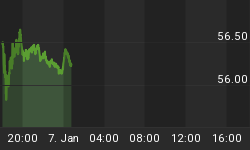Here's an update of the 5 charts shown in my October 21, 2003 communication:
First comes a scatter chart in which the CI-NCI Ratio smoothed by six 10-day moving averages is plotted against the NYSE Trin smoothed by six 10-day moving averages. The time span covers the first 222 trading days after the 4/28/78 and 5/30/03 deep monthly DJIA Coppock Curve buy signals.

Second and third come line charts showing each of the above 2 coordinates separately over the 500 trading days before and after the same 2 signal dates.


Fourth comes the latest update of the Monthly DJIA line chart showing the 24 months before and after the same 2 signals.

Fifth comes a line chart of Peter Eliades' CI-NCI Ratio.

The Six by Ten Trin has undergone a big drop. The Six by Ten CI-NCI Ratio has dropped too, but still has much further to go. Thus, while the green path in the scatter chart has dived deep, it should, upon rebounding (starting next week), continue moving leftward. This may reflect the "catching up" behavior that the green path needs to demonstrate with respect to the coral path in order to preserve the pattern pair.















